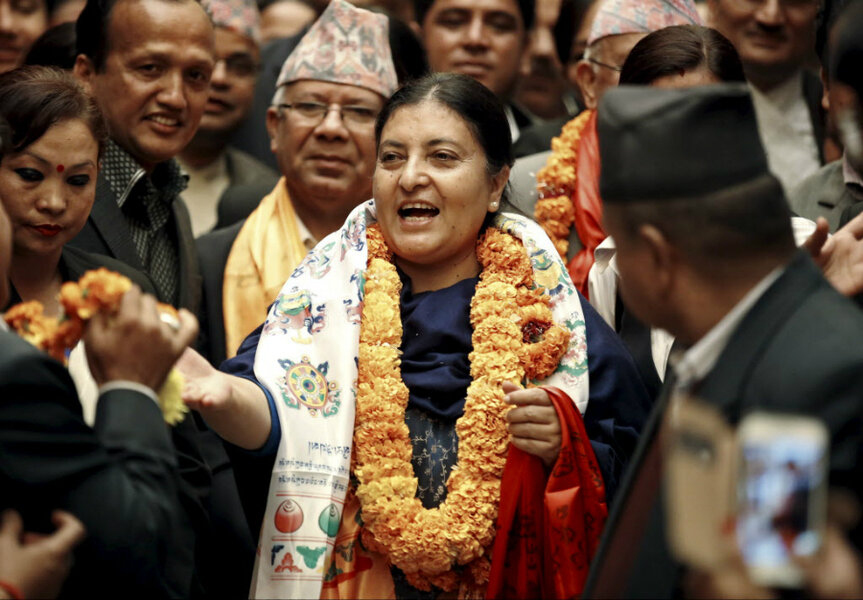Nepal elects first female president, but gender equity remains elusive
Loading...
Nepal has elected a female president for the first time in its history.
Bidhya Devid Bhandari was selected to become ceremonial head of state as a member of the Communist Party of Nepal (CPN), defeating her opponent in a 327-214 vote in Parliament.
Ms. Bhandari will succeed Ram Baran Yaday of the Nepali Congress Party, who had served in the post since 2008, reports the Economic Times of India.
Nepal’s newly amended constitution, adopted in September, requires women to make up a significant portion of parliament, assemblies, and governmental committees.
Bhandari's election follows the ascension of Nepali Parliament’s first woman speaker, Onsari Gharti, who was chosen last week – and who proclaimed Bhandari’s victory.
"I announce that Bidhya Devi Bhandari has been elected to the post of Nepal's president," said Ms. Gharti, Agence France-Presse reported Wednesday afternoon.
Bhandari has been an ardent proponent for women’s rights in Nepal’s male-centric culture and campaigned for a change to the country’s constitution, which now mandates that one-third of parliamentary members must be women. At least one woman must be elected as president or vice president, the constitution now requires.
In Nepal, the president is a largely ceremonial position; Prime Minister Khadga Prasad Oli will remain Nepal's political leader.
Bhandari is her party’s vice-chair and the widow of another high-ranking politician, Madan Bhandari, who served as CPN’s president before he was killed in 1993 in a car accident.
She began her political rise as a teenager and won two terms in parliament before serving as Nepal’s defense minister.
Nepal's 10-year civil war, beginning in 1996, fractured the country amid a Maoist insurgency. In 2006, Bhandari led a push to remove Nepal’s King Gyanedra. Two years later, the end of the conflict was predicated on a move to democratic elections, in which the rebels won many seats.
Despite the change in Nepal’s constitution, a caste system remains prevalent in Nepal, and ethnic-based discrimination is common, reports Human Rights Watch. Protesters from Nepal’s ethnic minorities told Agence France-Presse that new federal structures will leave them under-represented in parliament.
Gender balance remains elusive for the small Himalayan nation. Only 53 percent of women can read, reports the the CIA's World Factbook, compared to 76 percent of men.
The World Economic Forum’s Gender Gap Report has consistently ranked Nepal near the bottom of the pack for gender inequalities. In the most recent analysis, in 2013, Nepal was slotted 121st out 135 countries, slipping from 111th in 2006.
But the report shows a glimmer of hope. Although Nepali women rank low in terms of economic participation, health, and education, they rank 43rd in the world for political participation. With the newly installed constitution, women have a chance to orchestrate sweeping changes in Nepal.
Bhandari will be sworn in on Thursday by Chief Justice Kalyan Shrestha, The Himalayan Times reports.





